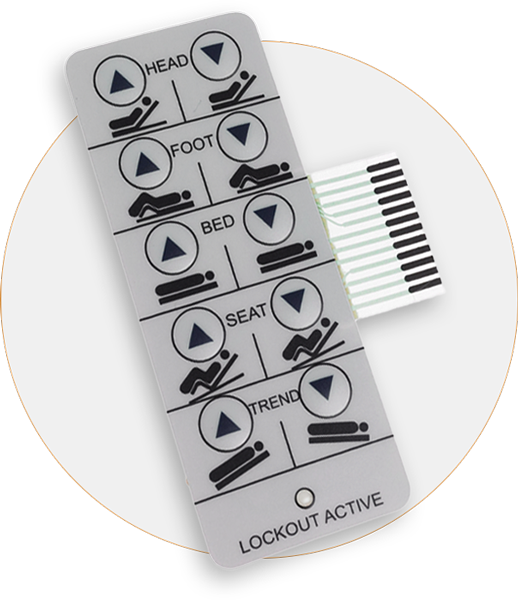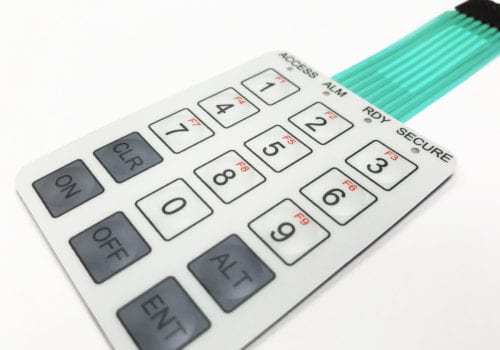Understanding the Relevance of Membrane Switches in Individual Interfaces
Membrane buttons are important components in the layout of efficient interface, assisting in not only performance but additionally improving aesthetic charm and user interaction. Their one-of-a-kind functions, such as resistance to personalized layouts and ecological aspects, make them ideal for a diverse variety of applications across multiple markets. As we discover the various benefits and future trends related to Membrane innovation, it becomes clear that these switches are extra than just components; they stand for a merging of innovation and functionality. The effects of this innovation on individual experience deserve examining even more.
What Are Membrane Buttons?

The spacer layer, which consists of sticky residential properties, permits the separation of the circuit layer from the overlay, guaranteeing that the button continues to be in a non-activated state up until pressed. When stress is put on the overlay, it compresses the spacer layer, linking the gap and completing the circuit in the underlying layer. This design not just minimizes the physical space needed for standard mechanical switches yet likewise enhances the durability of the tool, as Membrane switches are usually immune to dust, wetness, and other ecological elements.
Commonly discovered in applications varying from customer electronics to clinical gadgets, Membrane buttons are indispensable to modern technology, supplying a reliable and straightforward user interface that lines up with contemporary layout needs.
Advantages of Membrane Buttons
While many button technologies exist, Membrane Switches deal distinctive advantages that make them particularly desirable in various applications. Among the primary advantages of Membrane switches is their small layout, which allows for space-saving applications in devices where real estate is restricted. Their thin profile not just enhances aesthetic allure however additionally helps with light-weight building and construction.
Another considerable benefit is their resistance to environmental elements. Membrane buttons are typically secured against dampness, dirt, and pollutants, making them perfect for usage sought after settings, such as medical devices and industrial devices. This durability extends the life expectancy of the button, lowering upkeep costs and enhancing reliability.
Furthermore, Membrane switches can be personalized to satisfy certain layout needs, including one-of-a-kind graphics and colors that enhance user interaction. Their responsive comments alternatives can additionally be customized to provide a rewarding customer experience. Furthermore, Membrane switches are cost-effective, especially in high-volume applications, as they can be produced efficiently.
Applications in Different Industries

In the consumer electronic devices industry, Membrane switches are prevalent in tools such as microwaves, washing equipments, and remotes. Their tactile feedback try this out and visual options boost individual experience while providing a smooth, modern appearance. Additionally, vehicle producers utilize Membrane switches in control panel controls and infotainment systems, where room is limited, and individual engagement is important.
Furthermore, the commercial sector leverages Membrane switches in control panels for equipment and tools, permitting for intuitive procedure in often rough atmospheres. Their resistance to chemicals and moisture ensures durability and reliability in these applications. On the whole, the flexibility of Membrane Switches adds significantly to their extensive usage, making them important in various technological domains.
Layout Factors To Consider for Membrane Switches

When making Membrane buttons, numerous key considerations should be taken into consideration to make certain optimum capability and user experience. The choice of products is essential; selecting durable, high-grade substratums can improve the switch's durability and resistance to environmental factors such as moisture and temperature level variations.
Second of all, the design of the visuals overlay must focus on clearness and ease of usage. Symbols and text should be legible, and the layout needs to help with user-friendly communication (membrane switches). Additionally, tactile responses is crucial; integrating a tactile dome or various other devices can improve the user experience by giving physical verification of activation
Another vital aspect is the switch's electric performance. Designers have to make sure that the conductive traces are properly made to lessen resistance and avoid signal disturbance. This involves analyzing the needed actuation force and ensuring compatibility with the digital components they will certainly interface with.

Future Fads in Membrane Innovation
As modern technology remains to breakthrough, Membrane buttons are positioned to advance significantly, driven by advancements in materials and producing strategies. One emerging pattern is the unification of advanced materials, such as conductive inks and adaptable substrates, which boost resilience and minimize the total weight of Membrane buttons. These materials not only enhance the responsive feedback but likewise enable the layout of switches that find out here now can endure harsher ecological problems.
In addition, the integration of touch-sensitive technologies is changing typical Membrane Switches into more interactive interface. Capacitive touch sensors embedded within Membrane switch panels can supply a much more receptive and instinctive user experience, straightening with the growing demand for sleek, contemporary styles in consumer electronics.
Furthermore, improvements in printing strategies, such as electronic and 3D printing, make it possible for quick prototyping and modification of Membrane buttons. This flexibility allows producers to respond more quickly to market demands and customer choices.
Last but not least, sustainability is becoming a substantial emphasis, with suppliers discovering green products and processes. As these trends unravel, the future of Membrane technology guarantees boosted capability, aesthetic charm, and ecological responsibility, strengthening their role in innovative individual interfaces throughout different markets.
Final Thought
Finally, Membrane Switches represent an essential component in the design of interface, integrating capability with aesthetic adaptability. Their benefits, including durability and resistance YOURURL.com to environmental elements, make them suitable for diverse applications throughout various markets. Additionally, thoughtful layout factors to consider boost individual interaction and experience. As advancements in innovation continue, the evolution of Membrane buttons is anticipated to additional improve user interfaces, driving advancement and improving use in an increasingly complex technological landscape.
Membrane buttons are essential parts in the design of effective user interfaces, helping with not just performance however additionally enhancing aesthetic charm and customer communication.Membrane Switches offer as an important element in different customer interfaces, promoting a seamless interaction between customers and digital tools.While numerous switch technologies exist, Membrane Switches offer distinct advantages that make them especially desirable in different applications.Additionally, Membrane switches can be personalized to satisfy specific design requirements, incorporating unique graphics and colors that enhance user interaction.In conclusion, Membrane Switches stand for a crucial element in the style of individual interfaces, incorporating functionality with visual adaptability.